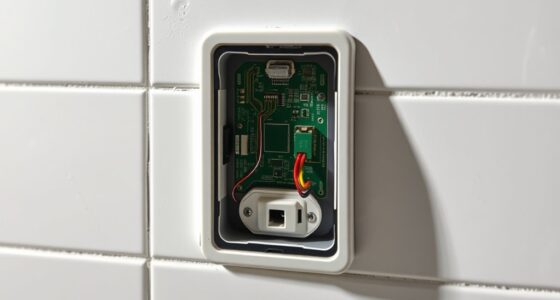If your breaker trips randomly, start by inspecting for common causes like loose connections, damaged wiring, or overloaded circuits. Turn off the main switch before checking outlets, switches, and the fuse box for corrosion or signs of wear. Look for flickering lights, burning smells, or hot outlets, which indicate issues. If you keep experiencing trips, there’s more to uncover—continue exploring to find the best solution.
Key Takeaways
- Turn off power and inspect for loose connections, damaged wiring, or signs of corrosion in the fuse box.
- Identify overloads by monitoring breaker trips during high power usage or with certain appliances.
- Check for short circuits through burnt smells, sizzling sounds, or visible sparks at outlets and switches.
- Test devices and wiring for faults, damage, or deterioration that could cause intermittent trips.
- Consult a licensed electrician if trips persist, especially when dealing with complex loads or suspected wiring issues.
Common Causes of Random Breaker Trips
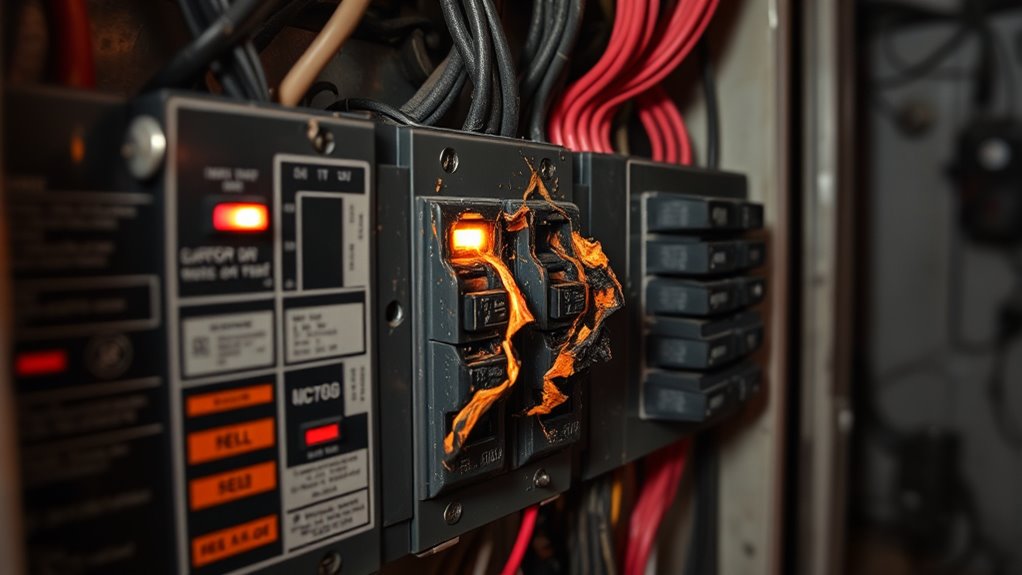
When a circuit breaker trips unexpectedly, it often points to underlying issues that need addressing. One common cause is fuse box issues, such as loose connections or faulty components, which can cause inconsistent power flow and trip the breaker. Outdated wiring also plays a significant role; old or damaged wiring can create short circuits or overloads that trigger the breaker to shut off automatically. Additionally, if your fuse box isn’t properly maintained or has corrosion, it can lead to erratic trips. Recognizing these problems early helps prevent further damage or fire hazards. Regular inspections and upgrades of your fuse box and wiring can reduce the chances of random breaker trips, keeping your electrical system safe and reliable. Proper maintenance of electrical components, including checking for corrosion and loose connections, is essential for ensuring safe and consistent power distribution. Ensuring proper electrical system maintenance can help identify potential issues before they cause unexpected breaker trips.
How to Safely Inspect Your Electrical System
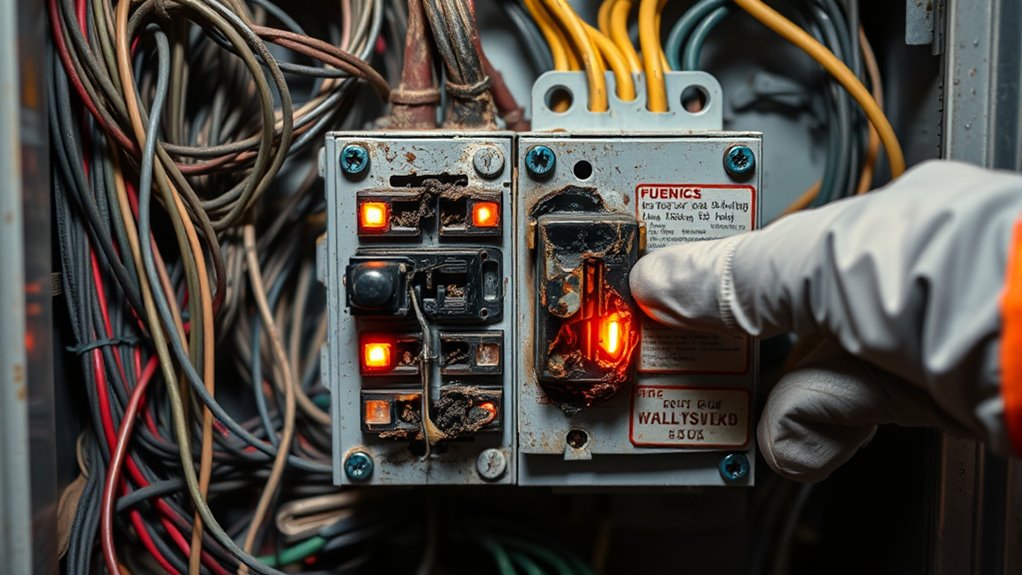
To safely inspect your electrical system, start by turning off the main power supply to eliminate the risk of electric shock. Once shut off, check for signs of ground faults, such as unusual scorch marks or tripped breakers. Look for circuit imbalances, which may cause flickering lights or uneven power distribution. Carefully examine your outlets, switches, and wiring for damage, loose connections, or corrosion. Use a flashlight to see into dark areas and a multimeter to test voltage levels safely. Keep in mind that grounding issues often lead to ground faults, and circuit imbalances can cause breaker trips. Additionally, understanding the importance of proper grounding techniques can help prevent many electrical issues. Modern electrical systems increasingly rely on automation to monitor and manage power distribution effectively, which can aid in early fault detection. Ensuring your system has proper circuit protection devices can help prevent overloads and protect your wiring from damage. Implementing effective filtration and pump protection measures can also prevent debris from causing electrical or mechanical problems in connected systems. Regular system maintenance and inspections can also help identify potential problems before they become serious. If you notice any irregularities or feel unsure, it’s best to consult a licensed electrician rather than proceeding further. Your safety is the top priority.
Identifying Overloads and Short Circuits
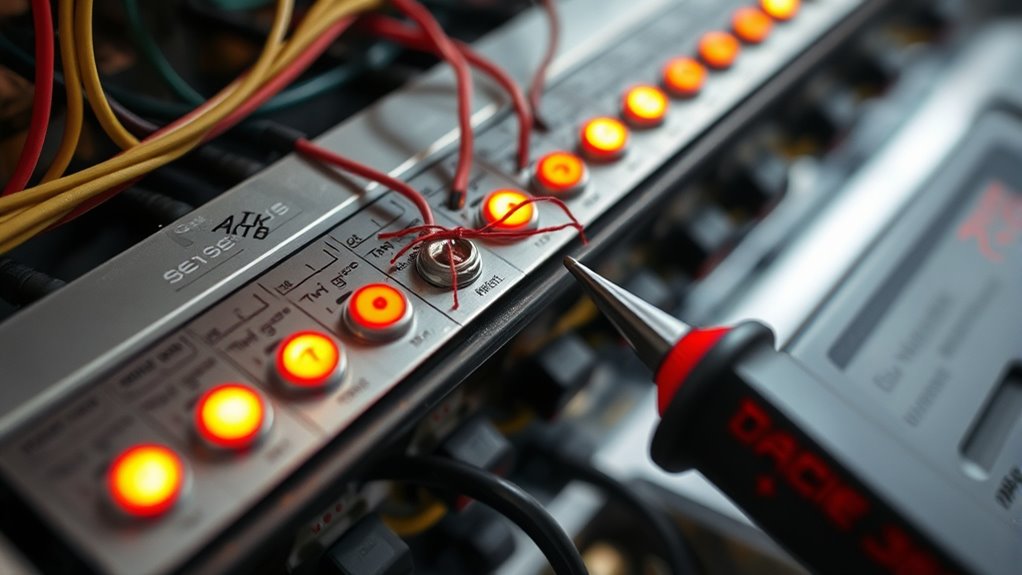
After inspecting your electrical system, you may notice signs of overloading or short circuits that could be causing your breaker to trip unexpectedly. Identifying these issues is vital for safety and preventing damage. Look out for:
- Frequent breaker trips during high power use
- Burning smells or sizzling sounds near outlets
- Warm or hot switches and outlets
- Flickering or dimming lights
- Visible damage or sparks at outlets
A circuit overload occurs when too many devices draw power simultaneously, overloading the circuit. Ground faults happen when current leaks to the ground, often causing the breaker to trip as a safety measure. Recognizing these signs helps you pinpoint the cause, so you can take proper steps to fix the problem and keep your system safe. Monitoring electricity consumption can also help prevent overloads before they occur. Additionally, understanding headphone connectivity options can help ensure your devices are functioning properly without adding unnecessary load to the system. Being aware of local electrical codes is essential for safe repairs and modifications. Regular inspections and electrical safety practices can further reduce the risk of unexpected trips and potential hazards. Conducting professional electrical assessments can provide a thorough diagnosis and ensure your system is functioning optimally.
The Role of Faulty Devices and Wiring
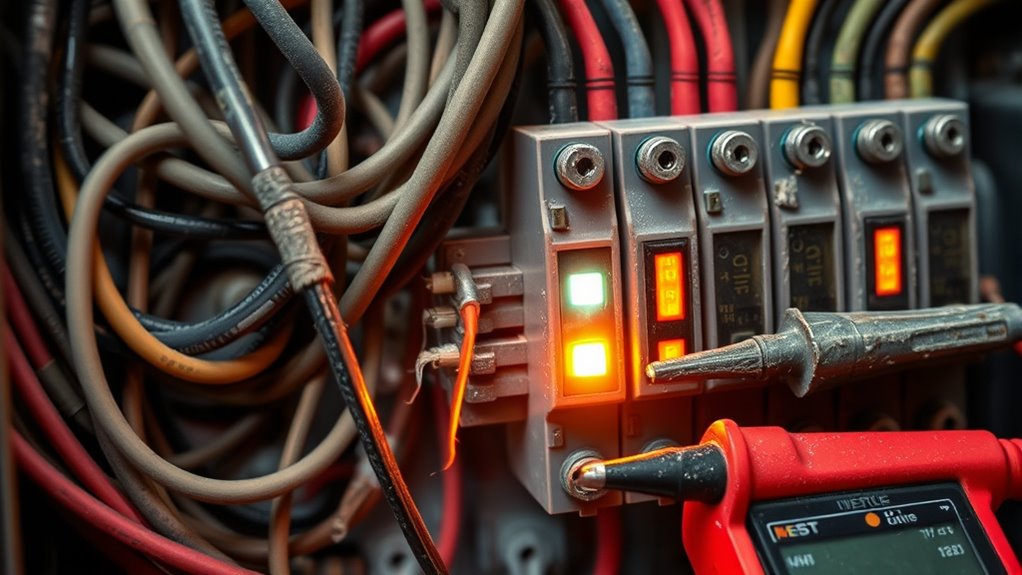
Faulty devices and damaged wiring are common causes of unexpected breaker trips. Faulty switches, for example, can create intermittent connections that overload the circuit or cause short circuits, leading to trips. Worn wiring is another culprit; as insulation deteriorates or wires loosen over time, they may cause arcing or short circuits. If you notice flickering lights or burning smells, these are signs that wiring might be compromised. Always inspect devices and wiring for visible damage or wear. Replacing faulty switches and repairing worn wiring can prevent unnecessary trips and reduce fire hazards. Keep in mind that even small issues with wiring or devices can have significant impacts on your breaker’s performance, so regular checks are essential for safety and reliability. Additionally, understanding the significance of proper wiring can help prevent future electrical problems.
When to Call a Professional Electrician

While inspecting your wiring and devices can help identify obvious issues, some problems are best left to a professional electrician. If you experience frequent breaker trips due to ground faults or circuit overloads, it’s time to call in an expert. They can safely diagnose complex issues that could pose safety risks. Consider calling a professional if:
- You notice persistent breaker trips without clear cause
- You suspect a ground fault in your wiring or appliances
- Your circuits frequently overload, especially during high power use
- You see signs of damaged or frayed wiring
- You’re unsure about handling electrical repairs yourself
- electrical load balancing is complex, and addressing these problems often requires understanding electrical load balancing and specialized troubleshooting techniques. Additionally, handling smart home devices or security systems may introduce additional challenges that require professional expertise. Proper electrical system assessment helps prevent hazards such as fires or shocks, which can be dangerous for all residents. Recognizing the importance of professional electrical services ensures that issues are resolved safely and efficiently.
Frequently Asked Questions
Can Frequent Breaker Trips Indicate a Serious Electrical Fault?
Yes, frequent breaker trips can indicate a serious electrical fault. It’s a sign you need to prioritize electrical panel maintenance and check for issues like breaker overload management. Ignoring these trips might lead to overheating or electrical fires. Regular inspections help identify underlying problems early, ensuring your system runs safely. Don’t delay; addressing frequent trips promptly keeps your electrical system reliable and prevents potential hazards.
Are There DIY Solutions for Persistent Breaker Trips?
Yes, you can try DIY troubleshooting for persistent breaker trips, but be cautious. Start by inspecting for loose connections or overloaded circuits. If these don’t work, consider breaker replacement, but only if you’re comfortable with electrical work and turn off the power first. For serious or repeated issues, it’s best to consult a professional electrician to avoid risks and guarantee safety.
What Safety Precautions Should I Take Before Inspecting Breakers?
Before inspecting breakers, prioritize electrical safety by turning off the main power supply to prevent shocks. Wear insulated gloves and use insulated tools for inspection procedures. Avoid working in wet or damp conditions, and make certain your hands are dry. Keep a fire extinguisher nearby, and never attempt repairs if you’re unsure or uncomfortable. Always follow manufacturer instructions and consult a professional if needed to guarantee safety during the inspection process.
How Can I Prevent Breaker Trips Caused by Power Surges?
To prevent breaker trips caused by power surges, you should install surge protectors on your main and individual circuits. These devices absorb excess voltage, shielding your wiring and appliances. Additionally, consider wiring upgrades if your system is outdated or prone to surges. Regularly inspect and maintain your electrical system to guarantee everything is functioning correctly, minimizing the risk of surges that could trip your breakers unexpectedly.
Is It Safe to Reset a Breaker Immediately After It Trips?
Think of resetting a breaker like restarting a car engine—sometimes it works, but other times, it’s risky. You shouldn’t reset immediately after a trip, especially if you suspect a circuit overload or breaker compatibility issue. Doing so can cause damage or fire. Instead, turn off appliances, check the breaker’s rating, then wait a few minutes. If it trips again, consult a professional to guarantee safety before resetting.
Conclusion
When your breaker trips randomly, think of it like a warning sign flashing on your dashboard. You need to carefully investigate the common causes, from overloads to faulty wiring, before jumping to conclusions. If you’re unsure or the problem persists, don’t hesitate to call a professional electrician—it’s better to be safe than sorry. Tackling electrical issues is like steering through a maze; having an expert guide you guarantees you reach safety without getting lost.



